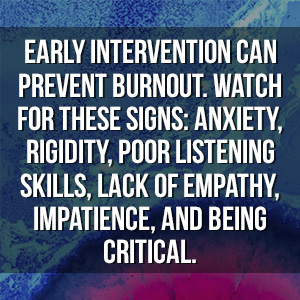This is part of a series publishing portions of a research paper on How a Leader Maintains High Productivity Without Team Burnout. I have decided not to publish the conclusion from my paper, instead I am supplying a bulleted list of key points. Each of these key points could be a book or blog post in and of itself. So, think of this as a list of ideas to explore if you want to prevent burnout for yourself or individuals in your team.
All in all, I’d say the most important take-away is this:
Early intervention can prevent burnout

Key Points for Leaders:
Listening and caring for employees is the most important thing to learn to do as a leader.
- Learn to interact well with others by listening, communicating and using self-control.
- Develop the attributes you want from your employees; people learn by seeing others model the behavior
- Develop coaching skills; Make feedback a natural part of interactions with employees
- Empower employees and provide clarity via effective communication
- Provide employees with control wherever possible; employees with decision-making power have lower burnout rates
- Intervene when employees provide subtle clues that they are being pushed to their limits. Learn more about symptoms in Appendix A (An overview of burnout) and Appendix B (The seven aspects of burnout).
- Provide goals and hope especially in difficult situations
- Keep your eyes open for indications that an individual is experiencing distress.
Signs of emotional distress include anxiety, rigidity, poor listening skills, lack of empathy, impatience, and being critical.
- Watch for, and acknowledge when people do something good
- Have grace for mistakes
- Champion changes that will create a company culture that builds engagement and person-job fit.
- Creating trust within your team so members share their real opinions without fear
- Remove barriers that are getting in your team’s way
- Communicate clear expectations
- Prevent stress whenever possible, especially stress that extends over a long period of time.
- Identify and coach employees that have the two personality traits that often lead to burnout: over-identification with work and a desire for recognition.
- Learn to effectively manage your own energy and learn how to “mobilize, focus, invest and renew the collective energy of those [you] lead.” (Loehr & Schwartz, 2003, pp. 5)
More than any other factor, the improvement of communication and the dissemination of information has the greatest impact in creating a culture of engagement
Key Points for Individuals
- Learn to identify when you’re tipping from (good) stress to distress; Don’t ignore early warning signs that you’re distressed.
- Identify when you’ve been stressed for too long or too intensely and ask for help.
- Develop coping mechanisms, skills, and behaviors that help you meet the challenges of your profession
- Examine the beliefs you have about whether stress is beneficial or harmful.
- Examine the beliefs you may have that contribute to burnout. For example:
seeing everything as an emergency, overdependence on self, failure to effectively delegate, not seeing self-care as integral to performance, and failing to make lifestyle choices that increase healthiness (Cora, 2010, pp. 21-4).
- Develop habits that allow you to effectively manage your energy. This requires you to be connected to your needs, values, strengths, and weaknesses
- Burnout is a process that is often overlooked for a long period of time. Learn to recognize the phases: emotional exhaustion, depersonalization, and reduced personal accomplishment. (Maslach, 1982). Learn more in Appendix A and Appendix B.
It is manifested by symptoms of severe exhaustion and distress at being overwhelmed and over-extended, feelings of ineffectiveness and inadequacy, reduced motivation and commitment, and ‘dysfunctional attitudes and behaviors at work’.
- Develop very specific routines that ensure you are regularly renewed; block off time to rest
- Learn to pace yourself
- Keep an eye on your sleeping and eating habits; these are good indications of how you’re doing
- Know your risk factors for burnout: under age 20, being an “over achiever” (very high level of motivation to succeed in your careers and high expectations and goals about your own accomplishments), feeling stuck in a job-person mismatch.
REFERENCES
The series
- Part 1: How a Leader Maintains High Productivity Without Team Burnout
- Part 2: An overview of burnout from Preventive stress management in organizations
- Part 3: The seven aspects of burnout
- Part 4: Insights from an experienced leader
- Part 5: Learn to manage energy.
- Part 6: Guard against distress and utilize stress as a tool for growth.
- Part 7: The six areas of job-person mismatch
- Part 8: Build engagement through company culture.
- Part 9: Key points


